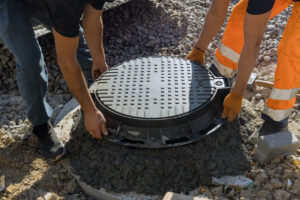The Science Behind Septic Repairs: Breaking Down What’s Happening Underground

When it comes to home maintenance, septic systems are often overlooked until something goes wrong. But did you know that your septic system is a sophisticated piece of technology working quietly underground? It’s designed to process waste and keep your home’s plumbing running smoothly.
Understanding how these systems function, what can go wrong, and how repairs are made can save homeowners a lot of stress and costly repairs. Let’s dive into the science of septic systems and break down what’s happening beneath your feet.
How Does The Septic System Function And What Causes It To Fail?
At its core, a septic system is designed to treat wastewater from your home. It does this by separating solids from liquids and filtering out contaminants before allowing the treated water to return to the environment. Let’s break this process down in simple terms:
- Wastewater enters the septic tank: All the water used in your home – from toilets, sinks, showers, dishwashers, and washing machines – flows into the septic tank. The tank is usually made of concrete, plastic, or fiberglass and is buried underground. Inside the tank, the water is separated into three layers:
- Sludge: Solid waste that settles at the bottom.
- Effluent: The liquid layer in the middle.
- Scum: Grease, oils, and floatable solids that rise to the top.
- Waste treatment: The effluent (middle liquid layer) flows from the tank into a drain field or leach field, where it undergoes further treatment as it percolates through soil. The soil filters out harmful bacteria and other contaminants before the water is absorbed back into the ground.
However, as efficient as this system sounds, various factors can lead to failure. Over time, the septic system’s ability to process waste diminishes. Common causes of septic system failure include:
- Lack of maintenance: Without regular pumping and cleaning, sludge and scum build up, causing blockages.
- Clogged or damaged pipes: Pipes leading to the tank or drain field can get clogged with debris or become damaged.
- Excessive water usage: Too much water from appliances, showers, or toilets can overwhelm the system, causing it to fail.
- Tree roots: Tree roots can grow into pipes or the tank, blocking the flow of wastewater.
- Poor soil conditions: Soil that doesn’t allow proper filtration can result in untreated wastewater seeping into the environment.
So, what’s happening when things go wrong? When the system becomes clogged or blocked, the water may not be able to flow as efficiently, leading to backups in the home, unpleasant odors, or even wastewater surfacing in the yard. If left untreated, a failed septic system can pose serious health risks due to contamination of groundwater.
What are the Common Issues That Lead to Septic System Repairs?
Septic systems are built to last, but they do require periodic maintenance and occasional repairs. Here are the most common issues that lead to septic system repairs:
- Clogged Pipes: Over time, debris like grease, non-biodegradable materials, and toilet paper can build up in the pipes leading to or from the septic tank. This leads to blockages and prevents wastewater from flowing freely, causing backups in the home or yard.
- Full or Overfilled Septic Tank: A septic tank needs to be pumped every few years to remove sludge and scum that accumulates. If this isn’t done, the tank can become overfilled, making it unable to properly separate and treat wastewater. An overfilled tank is one of the most common causes of septic system failure.
- Drain Field Issues: The drain field is a crucial part of the system that allows water to slowly percolate back into the soil. If the field becomes clogged or saturated with water, it can lead to surface water pooling or a foul odor around the drain field.
- Leaking Tank: Over time, the septic tank itself may develop cracks or leaks, allowing wastewater to escape into the surrounding soil. This is particularly problematic, as it can lead to contamination of the groundwater.
- Tree Roots: Tree roots love to find moisture, and your septic tank or drain field is a prime target. Roots can infiltrate pipes, causing blockages and restricting the system’s ability to process waste properly.
- Soil Compaction: Heavy machinery, vehicles, or foot traffic over the drain field can cause the soil to become compacted, restricting the flow of effluent and preventing proper filtration. This can lead to backups and system failure.
How Do Professionals Diagnose Septic System Problems Underground?
Diagnosing septic system problems isn’t as easy as flipping a switch. Since the system is largely buried underground, it requires specialized tools and expertise. Here’s how professionals typically approach diagnosing a septic issue:
- Inspection of the Tank and Pipes: The first step is usually a visual inspection. A technician will uncover the tank and inspect the pipes for any obvious signs of damage or leaks. This may involve opening the tank to look for sludge buildup, checking the water level, and testing the effluent for clarity. They might also inspect the pipes for any obvious cracks, clogs, or blockages.
- Pump and Clean the Tank: If the tank is full, the technician will pump out the waste to assess the condition of the system more thoroughly. This gives them a clearer picture of whether the tank needs repairs or if the issue lies elsewhere in the system.
- Dye Testing: To identify issues with the drainage field or pipes, professionals sometimes use dye testing. A harmless dye is introduced into the system, and the technician monitors where it exits the system. This helps pinpoint areas of clogging or leaks in the pipes or drain field.
- Camera Inspection: Modern technology has made diagnosing septic problems much easier. A technician can insert a small camera into the pipes to get a real-time video of the system’s interior. This allows for precise identification of cracks, tree root invasion, blockages, and other issues.
- Soil Percolation Test: Sometimes, issues with drainage are not about the pipes but the soil itself. A percolation test can be performed to check how well the soil in the drain field absorbs water. If the soil has become too compacted or contains too much clay, it could hinder the system’s ability to function properly.
What Role Does Soil Composition Play in Septic System Performance?
While we often think of septic systems as mechanical, the role of soil cannot be underestimated. The soil surrounding the septic system, particularly the drain field, plays a significant part in the treatment process. Here’s how soil composition impacts your septic system’s performance:
- Soil Structure and Texture: Sandy soils are ideal for septic systems because they allow water to flow through quickly, filtering out contaminants as it moves downwards. On the other hand, clay soils are dense and compact, leading to slow drainage and inadequate filtration. Loam soils, which are a mix of sand, silt, and clay, are typically the best option for septic systems because they balance water retention and filtration.
- Absorption Rates: For a septic system to work efficiently, the soil needs to absorb effluent slowly over time. If the soil is too dense or poorly aerated, water will pool on the surface instead of filtering into the ground. This can lead to wastewater backing up into the tank or surfacing near the drain field.
- Soil Contamination: Soil around the drain field can also become contaminated if the septic system is not properly maintained. If wastewater begins to leak into the surrounding soil, it can pollute the groundwater and cause a serious environmental hazard.
Understanding the role of soil composition helps homeowners make informed decisions about system installation and maintenance. In some cases, soil tests or even replacing a poorly performing drain field may be necessary to ensure long-term system function.
A septic system is a complex but vital part of your home’s plumbing. It operates quietly underground to process waste, but when something goes wrong, it’s important to understand the science behind the issues at hand.
Whether it’s a full tank, clogged pipes, or soil issues, knowing what can cause a system to fail and how professionals diagnose the problem helps homeowners stay ahead of costly repairs. Regular maintenance, proper usage, and understanding the soil around your system will ensure that your septic system keeps running smoothly for years to come.
Get Reliable Plumbing Solutions with Full Spectrum Plumbing Services
At Full Spectrum Plumbing Services, we understand that plumbing issues can arise unexpectedly, causing stress and disruption in your daily life. That’s why we offer a wide range of top-notch plumbing services designed to address both urgent needs and long-term solutions. From leaky pipes and clogged drains to water heater installations and sewer line repairs, our experienced team is equipped with the expertise and tools to handle it all.
What sets us apart? We prioritize customer satisfaction with every service, ensuring we not only solve your immediate plumbing problems but also provide preventative solutions to avoid future issues. Our transparent pricing, efficient work, and commitment to quality ensure your home’s plumbing system is in the best hands.
Don’t let plumbing problems slow you down. Whether it’s a quick fix or a major installation, Full Spectrum Plumbing Services is here to provide the reliable, professional service you need. Contact us today and experience the difference!



